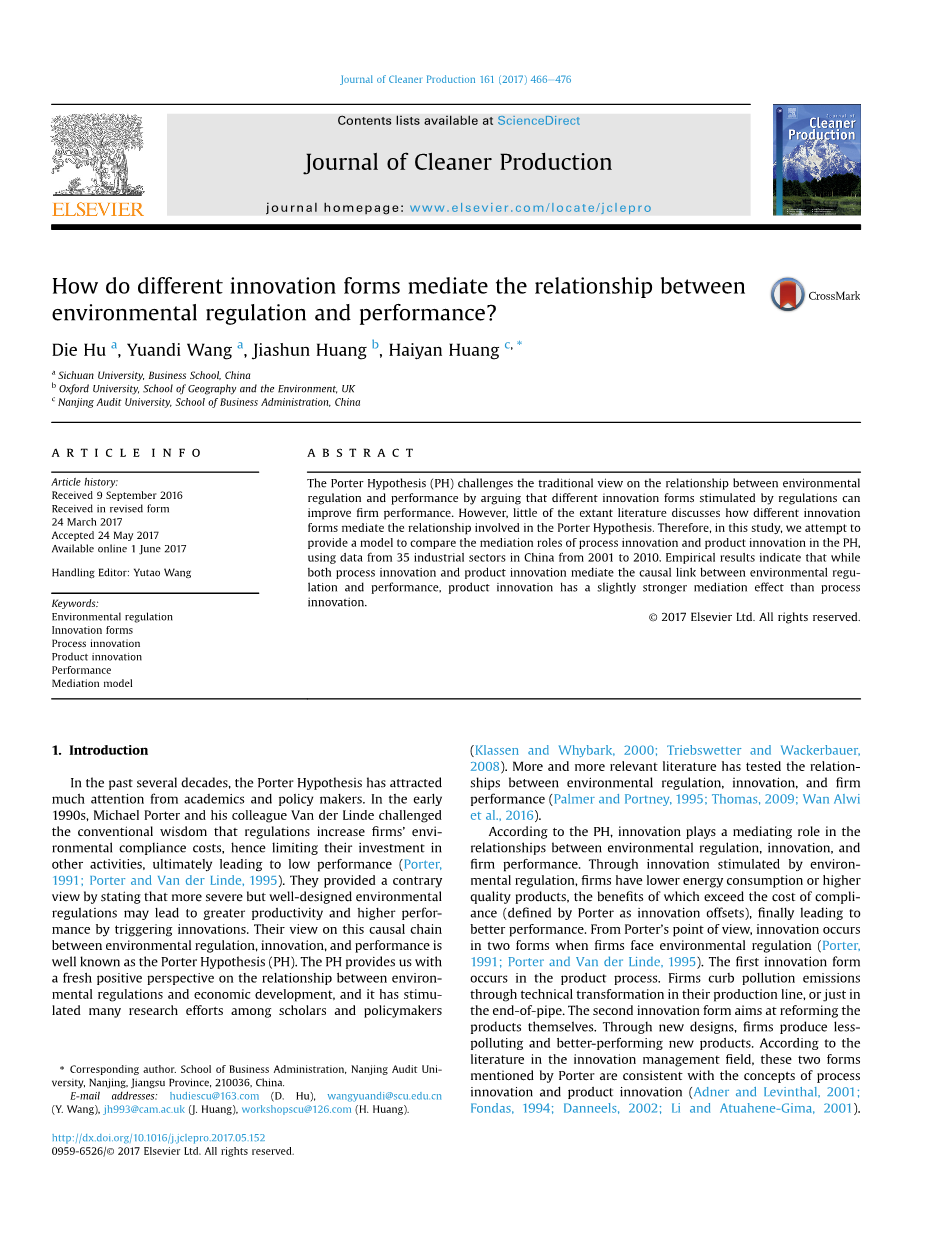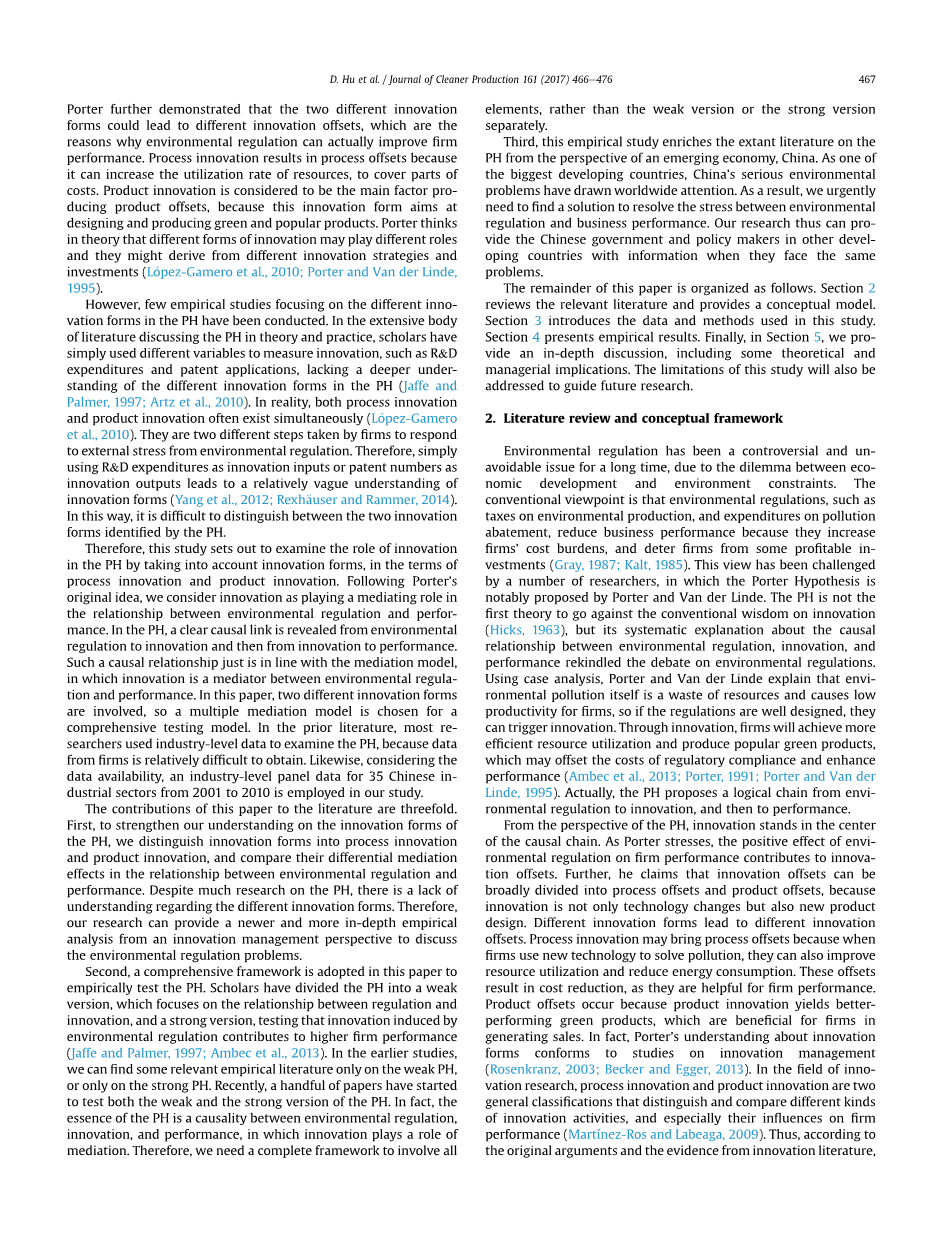

英语原文共 11 页,剩余内容已隐藏,支付完成后下载完整资料
How do different innovation forms mediate the relationship between environmental regulation and performance?
不同的创新形式如何调和环境监管与绩效之间的关系?
Abstract(摘要)
The Porter Hypothesis (PH) challenges the traditional view on the relationship between environmental regulation and performance by arguing that different innovation forms stimulated by regulations can improve firm performance. However, little of the extant literature discusses how different innovation forms mediate the relationship involved in the Porter Hypothesis. Therefore, in this study, we attempt to provide a model to compare the mediation roles of process innovation and product innovation in the PH, using data from 35 industrial sectors in China from 2001 to 2010. Empirical results indicate that while both process innovation and product innovation mediate the causal link between environmental regulation and performance, product innovation has a slightly stronger mediation effect than process innovation.
copy; 2017 Elsevier Ltd. All rights reserved.
波特假设(PH)通过论证受法规刺激的不同创新形式可以改善公司业绩,挑战传统的环境规制与绩效之间关系的观点。然而,现有文献中很少有人讨论在波特假设中不同的创新形式如何调和涉及的关系。 因此,在本研究中,我们尝试使用2001年至2010年中国35个工业部门的数据,提供一个模型来比较流程创新和产品创新在PH中的中介作用。实证结果表明,虽然流程创新和产品创新都调解环境监管与绩效之间的因果关系,但产品创新比流程创新具有更强的调解作用。
Keywords: Environmental regulation,Innovation forms, Process innovation, Product innovation, Performance, Mediation model
关键词:环境规制,创新形式,过程创新,产品创新,绩效,中介模型
1. Introduction(引言)
In the past several decades, the Porter Hypothesis has attracted much attention from academics and policy makers. In the early 1990s, Michael Porter and his colleague Van der Linde challenged the conventional wisdom that regulations increase firmsrsquo; environmental compliance costs, hence limiting their investment in other activities, ultimately leading to low performance (Porter, 1991; Porter and Van der Linde, 1995). They provided a contrary view by stating that more severe but well-designed environmental regulations may lead to greater productivity and higher performance by triggering innovations. Their view on this causal chain between environmental regulation, innovation, and performance is well known as the Porter Hypothesis (PH). The PH provides us with a fresh positive perspective on the relationship between environmental regulations and economic development, and it has stimulated many research efforts among scholars and policymakers (Klassen and Whybark, 2000; Triebswetter and Wackerbauer, 2008). More and more relevant literature has tested the relationships between environmental regulation, innovation, and firm performance (Palmer and Portney, 1995; Thomas, 2009; Wan Alwi et al., 2016).
在过去几十年中,波特假设引起了学者和政策制定者的极大关注。 20世纪90年代初,迈克尔·波特和他的同事范德·林德质疑传统观念,即法规增加了公司的环境合规成本,从而限制了他们对其他活动的投资,最终导致业绩不佳(Porter,1991; Porter和Van der Linde, 1995年)。他们提出了相反的观点,指出更严格但设计良好的环境法规可能会通过触发创新来提高生产力和提高绩效。他们对环境监管,创新和绩效之间这种因果关系的观点众所周知,即波特假设(PH)。 PH为环境法规与经济发展之间的关系提供了新的积极视角,并激发了学者和政策制定者的许多研究工作(Klassen和Whybark,2000; Triebswetter和Wackerbauer,2008)。越来越多的相关文献测试了环境监管,创新和企业绩效之间的关系(Palmer和Portney,1995; Thomas,2009; Wan Alwi等,2016)。
According to the PH, innovation plays a mediating role in the relationships between environmental regulation, innovation, and firm performance. Through innovation stimulated by environmental regulation, firms have lower energy consumption or higher quality products, the benefits of which exceed the cost of compliance (defined by Porter as innovation offsets), finally leading to better performance. From Porterrsquo;s point of view, innovation occurs in two forms when firms face environmental regulation (Porter, 1991; Porter and Van der Linde, 1995). The first innovation form occurs in the product process. Firms curb pollution emissions through technical transformation in their production line, or just in the end-of-pipe. The second innovation form aims at reforming the products themselves. Through new designs, firms produce less-polluting and better-performing new products. According to the literature in the innovation management field, these two forms mentioned by Porter are consistent with the concepts of process innovation and product innovation (Adner and Levinthal, 2001; Fondas, 1994; Danneels, 2002; Li and Atuahene-Gima, 2001). Porter further demonstrated that the two different innovation forms could lead to different innovation offsets, which are the reasons why environmental regulation can actually improve firm performance. Process innovation results in process offsets because it can increase the utilization rate of resources, to cover parts of costs. Product innovation is considered to be the main factor producing product offsets, because this innovation form aims at designing and producing green and popular products. Porter thinks in theory that different forms of innovation may play different roles and they might derive from different innovation strategies and investments (Lopez-Gamero et al., 2010; Porter and Van der Linde, 1995).
根据PH,创新在环境监管、创新和企业绩效之间的关系中起着中介作用。 通过环境监管的创新,企业拥有更低的能源消耗或更高质量的产品,其优势超过合规成本(由波特定义为创新补偿),最终带来更好的绩效。从波特的观点来看,当企业面临环境监管时,创新有两种形式(Porter,1991; Porter和Van der Linde,1995)。第一种创新形式出现在产品过程中,企业通过生产线上的技术改造或仅仅在管道末端来抑制污染排放。第二种创新形式旨在改革产品本身。通过新的设计,公司生产污染较少、性能更好的新产品。根据创新管理领域的文献,波特提到的这两种形式与过程创新和产品创新的概念一致(Adner和Levinthal,2001; Fondas,1994; Danneels,2002; Li和Atuahene-Gima,2001)。波特进一步证明,两种不同的创新形式可能导致不同的创新抵消,这也是环境监管实际上可以提高企业绩效的原因。流程创新导致流程抵消,因为它可以提高资源利用率,覆盖部分成本。产品创新被认为是产生产品抵消的主要因素,因为这种创新形式旨在设计和生产绿色和流行产品。波特在理论上认为,不同形式的创新可能扮演不同的角色,他们可能来自不同的创新战略和投资(L opez-Gamero et al。,2010; Porter and Van der Linde,1995)。
However, few empirical studies focusing on the different innovation forms in the PH have been conducted. In the extensive body of literature discussing the PH in theory and practice, scholars have simply used different variables to measure innovation, such as Ramp;D expenditures and patent applications, lacking a deeper understand
全文共55455字,剩余内容已隐藏,支付完成后下载完整资料
资料编号:[1457]
以上是毕业论文外文翻译,课题毕业论文、任务书、文献综述、开题报告、程序设计、图纸设计等资料可联系客服协助查找。


